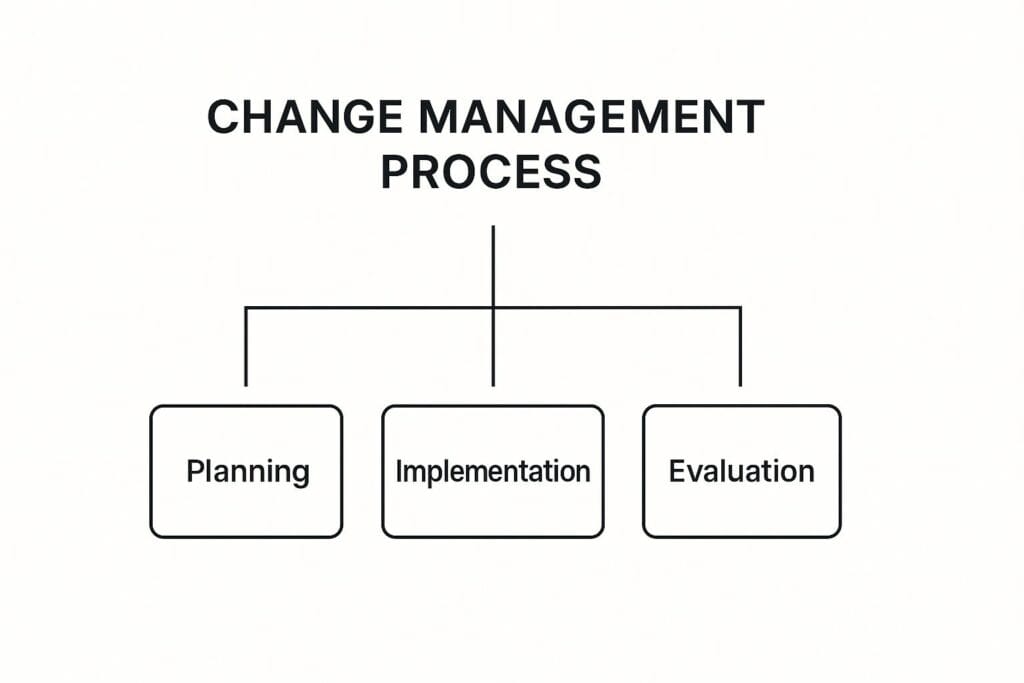In the dynamic worlds of politics, business, and economics, one constant remains: change. Could you please explain what organisational change management is and why it is essential for survival and growth?
At its core, organisational change management (OCM) is the structured, thoughtful process of guiding people and the company they work for from a known present to an unknown future. It’s less about the new technology or the revised org chart and all about the people who have to live with that change. OCM focuses on making sure new initiatives are adopted smoothly so the organisation can actually see the benefits, whether responding to economic shifts, new health regulations, or competitive pressures.
Why Do So Many Business Transformations Fail?
Every leader understands that change is the only constant. Whether you’re rolling out new software to comply with environmental standards, merging with another company after a major market shift, or pivoting your entire business strategy due to political developments, you have to evolve to survive. However, the corporate graveyard is teeming with the remains of promising projects that ultimately failed.
Why? Almost always, it stems from a fundamental miscalculation. Leaders allocate significant resources to the technical aspects of the change, such as the systems, processes, and project plans, but often fail to consider the crucial factor that will determine its success: their people.
This scenario is precisely where organisational change management proves its worth across all sectors, from business and technology to science and health.
A Framework for Navigating Change
To better understand this, visualise your organisation as a large ship. A major business transformation is like sailing directly into a storm. You, the captain, might have the best new navigation equipment and a solid vessel. However, if your crew is experiencing panic, confusion, or actively resisting the new course, you risk going off course. You might even sink.
Organisational change management is the discipline of being a skilled captain who not only plots the course but also prepares, guides, and supports the crew through the turbulence. It is a methodical approach to handling the human aspect of change, guaranteeing that all team members comprehend the destination, the purpose of the journey, and their respective responsibilities in weathering the challenges.
To help clarify this, let’s break down the key elements that make up the OCM discipline.
Key Elements of Organizational Change Management
| Component | Description | Primary Goal |
|---|---|---|
| Leadership Alignment | The goal is to establish a robust and cohesive front that fosters trust and dedication from the highest levels. | Identifying and involving all groups affected by the process change is crucial. |
| Stakeholder Engagement | The development of a clear, consistent, and two-way communication plan is crucial. | It is essential to identify and involve every group impacted by the process change. |
| Communication | The goal is to eliminate uncertainty, manage expectations, and ensure that everyone is informed and engaged. | We equip employees with the new skills and knowledge they need to succeed. |
| Training & Development | We aim to enhance people’s competence and confidence, making them ready for innovative methods of operation. | The process of resistance management involves the proactive identification and resolution of sources of pushback and concern. |
| Resistance Management | The goal is to comprehend the underlying reasons for resistance and transform opponents into advocates. | To understand the root causes of resistance and convert detractors into supporters. |
Ultimately, these components work together to create a comprehensive strategy that treats employees not as obstacles but as the engine of successful change.
The Hard Numbers Behind Failed Initiatives
A solid OCM strategy is not merely a desirable feature. The data paints a rather sobering picture. Research consistently shows that a staggering 60–70% of change initiatives fail to meet their objectives.
Only about 34% of major change projects are considered a complete success, according to an eye-opening study. This massive failure rate points to the gap between planning a change and actually embedding it into the company’s culture. If you’re interested in the details, you can explore more about these change management statistics and their implications.
Closing this gap is the entire purpose of organisational change management. It provides the frameworks and tools to turn a high-risk gamble into a well-managed success.
The Core Principles of Successful Change

We’ve talked about why so many change initiatives fall flat. Now, let’s shift our focus to what truly proves effective. Effective organisational change management goes beyond simply fulfilling project planning requirements. It’s about grounding your strategy with a real understanding of how people and organisations tick, whether in a fast-paced business or a methodical scientific institution.
At the core of any successful transformation, you’ll find three things working in harmony: authentic leadership, clear communication, and real employee involvement. When these elements are truly present, they create the trust and buy-in needed to move past the resistance that naturally comes with any major shift.
The Power of Active Leadership Sponsorship
If you take away only one thing, let it be this: the single biggest predictor of success is active and visible sponsorship from the top. And I don’t mean a kickoff email or a quick mention in a company-wide meeting. Real sponsorship is something people can see and feel, consistently, from start to finish.
Think about a company rolling out a complex new software platform.
- Passive Sponsorship: The CEO announces the project in an email and hands it off to IT. For everyone else, it’s just another “IT thing”, completely disconnected from the bigger picture.
- Active Sponsorship: The CEO talks about the why behind the new system in town halls, connecting it directly to the company’s future. Other leaders are seen using the software themselves—and are open about their own learning curves. This makes the effort feel genuine and important.
When leadership visibly champions a project, it sends a clear signal that this isn’t just another passing fad. It’s a priority. That top-level backing also provides the muscle needed to push through roadblocks and secure resources along the way.
When employees see their own managers and senior leaders walking the walk, they’re far more likely to follow suit. Study after study confirms that people look to their leaders for cues on how to respond to big changes at work.
Fostering Clear and Consistent Communication
Uncertainty breeds resistance. It’s just human nature. When people don’t have clear information, they fill in the blanks with rumours and worst-case scenarios. That narrative can poison a project before it even gets off the ground. This is why a strategic communication plan isn’t a “nice-to-have”—it’s absolutely critical for any organisation, be it in business, politics, or science.
So, what does good communication look like during a change?
- Consistent: The core message—the vision, the benefits, and the timeline—is repeated often and through different channels.
- Targeted: The information speaks directly to different groups, answering their specific “what’s in it for me?” questions and addressing their unique concerns.
- Two-Way: It’s not a monologue. You have to create real channels for people to ask questions, share feedback, and voice their worries. They need to feel heard.
Without this deliberate approach, you’re not managing the message; you’re letting the rumour mill manage it for you. This steady, clear flow of information is foundational to what organisational change management is all about.
Proven Models for Structuring Change
Trying to navigate a major business transformation without a roadmap is like setting sail without a compass—you’re likely to end up lost. The good news is you don’t have to invent your strategy from scratch. Over the years, experts have developed battle-tested frameworks that show what organisational change management actually looks like in practice. These models give you a structured path to guide your people from initial awareness to full adoption.
While plenty of models exist, a handful have become industry standards simply because they work so well across different situations. Getting to know these frameworks equips you with a strategic toolkit. It helps you pick the right approach for your specific challenge, whether you’re implementing a top-down corporate directive or trying to shift individual behaviours in response to new health and safety protocols.
This diagram breaks down the fundamental stages that underpin most successful change initiatives, from the initial idea all the way to measuring the results.

As you can see, a successful project needs dedicated focus on planning, executing, and evaluating the change. Skipping any of these steps is a risk you don’t want to take.
Lewin’s Change Management Model
One of the earliest and most influential frameworks comes from psychologist Kurt Lewin. Its power lies in its simplicity. He breaks the entire process down into three intuitive stages: unfreeze, change, and refreeze.
Think about a solid block of ice. You can’t just force it into a new shape. First, you have to unfreeze it by melting it down. In an organisation, this means preparing everyone for the change by challenging old habits, questioning existing structures, and getting people ready for what’s ahead.
Next, you make the change. Now that the ice is water, you can pour it into a new mould. This is the implementation phase where the new processes, systems, or strategies are introduced. It’s often a messy and confusing time, which is why clear communication and strong support are so critical here.
Finally, you refreeze the water in its new form. This last stage is all about making the new way of working stick. You solidify the change by weaving it into the company culture with new policies, rewards, and support systems to make sure people don’t slide back into old routines. Keeping such changes relevant is key, especially as markets evolve. For more on this, check out our guide on the top business trends to watch in 2025.
Kotter’s 8-Step Process For Leading Change
Developed by Harvard Business School professor John Kotter, this model offers a much more detailed, top-down game plan for large-scale transformations. Its big focus is on creating a powerful sense of urgency right from the start to build momentum.
Kotter’s eight steps provide a clear sequence for leaders to follow:
- Create Urgency: Make it clear why the change is absolutely necessary right now.
- Build a Guiding Coalition: Assemble a team with enough power and influence to lead the charge.
- Form a Strategic Vision: Develop a clear, simple vision of the future.
- Enlist a Volunteer Army: Communicate the vision broadly to get widespread buy-in.
- Enable Action by Removing Barriers: Get rid of obstacles that are holding people back.
- Generate Short-Term Wins: Plan for and celebrate small, visible victories to keep morale high.
- Sustain Acceleration: Use the credibility from early wins to tackle bigger challenges.
- Institute Change: Anchor the new approaches firmly in the corporate culture.
This framework is incredibly effective for major strategic shifts where decisive, top-down leadership is essential for success.
The Prosci ADKAR Model
While Kotter’s model looks at change from the top down, the Prosci ADKAR model flips the script and focuses on the individual’s journey. It’s built on a simple truth: organisational change is just the sum of many individual changes.
ADKAR is an acronym that represents the five outcomes each person must achieve for a change to stick: Awareness, Desire, Knowledge, Ability, and Reinforcement.
This bottom-up perspective is fantastic for diagnosing why a change initiative is failing. If people aren’t adopting a new software, a manager can use ADKAR as a checklist. Do they lack awareness of the need for it? Is there no desire to participate? Do they have the knowledge or ability to use it correctly? Or is there no reinforcement to keep them from going back to the old way? It gives managers a practical tool to pinpoint resistance and support their teams through personal transitions.
Comparison of Change Management Models
Each of these models offers a unique lens through which to view and manage change. There’s no single “best” one; the right choice depends entirely on your organisation’s specific situation, culture, and the nature of the change itself.
This table provides a quick comparison to help you understand which framework might be the best fit for your needs.
| Model | Core Focus | Best For |
|---|---|---|
| Lewin’s Model | A simple, three-stage process (Unfreeze, Change, Refreeze) | The approach is top-down and driven by leadership, with a focus on highlighting urgency and vision. |
| Kotter’s 8-Step Process | A top-down, leadership-driven approach emphasizing urgency and vision. | The approach is top-down and driven by leadership, with a focus on emphasising urgency and vision. |
| Prosci ADKAR Model | An individual-focused, bottom-up approach to personal transition. | Pinpointing and addressing individual resistance, coaching managers, and ensuring change sticks at the team level. |
By understanding the core focus of each model, you can select the one that aligns best with your goals. Often, the most successful initiatives actually blend elements from different models to create a hybrid approach that covers all the bases—from high-level strategy to individual support.
The Real-World Benefits of Managing Change

It’s easy to dismiss change management as a “soft” expense—something focused on feelings rather than financials. But that’s a critical misunderstanding. Investing in a formal change strategy is a hard-nosed business decision that directly produces measurable results across any field, including business, science, and even sports.
A structured approach is what separates a project that stumbles across the finish line from one that delivers its full, intended value. The data here is crystal clear. Research shows that organisations with excellent change management are six times more likely to meet or exceed their project objectives.
Why such a dramatic difference? It’s because skilfully managing the human side of change heads off the productivity dips, active resistance, and employee turnover that so often derail major initiatives.
Boosting Project ROI and Efficiency
At the end of the day, any business change—whether it’s a new software rollout or a complete departmental restructure—is meant to achieve a specific outcome. It could be higher revenue, greater efficiency, or a stronger position in the market. But without genuine buy-in from your people, those goals will always remain just out of reach.
A project can be a technical masterpiece, delivered on time and on budget. But if your team doesn’t adopt the new way of working, the projected ROI will never become a reality. Change management is the bridge between delivering a solution and realising its benefits.
This focus on adoption creates a ripple effect of financial and operational advantages.
- Staying on Budget and Schedule: When you manage the people side effectively, you’re far less likely to face the costly delays that come from resistance or rework.
- Minimising Productivity Slumps: Change naturally disrupts daily workflows. A solid OCM plan provides the training and support needed to shorten that learning curve and get teams back to peak performance faster.
- Reducing Employee Attrition: Thoughtful change management makes employees feel heard and supported, which significantly lowers the risk of losing your best people during uncertain times.
Building a More Resilient and Agile Organization
The benefits don’t just stop when the project ends. Practising good organisational change management builds a powerful, long-term capability within your company. Think of it like a sports team building its core strength. Each successful transition makes the entire organisation more resilient, adaptable, and ready for whatever comes next.
This agility is a massive competitive advantage, especially when economic and political shifts can redraw the entire business landscape overnight. For more on this, consider exploring how political shifts influence financial markets.
When your teams trust that leadership will guide them through transitions with care and a clear plan, they become less afraid of the unknown and more open to new ideas. This fosters a culture of continuous improvement, where change is seen not as a threat but as an opportunity for innovation and growth. In the long run, this foundational resilience might just be the greatest benefit of all.
How Technology Is Reshaping Change Management
While the fundamental human principles of change management haven’t changed, the tools in our toolkit certainly have. Technology—especially advances in data analytics and artificial intelligence—is pushing the practice from a reactive art form into a proactive, data-informed science. This shift gives leaders a chance to guide change with more precision and empathy than was ever possible before.
The days of relying only on annual surveys or gut feelings are behind us. Today, we have tools that can analyse employee sentiment in real time, pulling insights from everyday communications on platforms like Slack or Microsoft Teams. This gives change leaders an immediate, unfiltered look at how a transition is really landing, helping them spot resistance and confusion before they snowball into major problems.
The Rise of Data-Driven Change Leadership
This integration of technology unlocks a much more tailored and responsive way to manage organisational shifts. Instead of blasting out a single, one-size-fits-all communication plan, leaders can now fine-tune their strategies for specific teams or even address individual employee concerns.
This tech-powered approach brings some powerful new capabilities to the table:
- Predictive Analytics: AI models can sift through data from past projects to flag potential roadblocks. They can even predict which employee groups might struggle the most with an upcoming change, allowing leaders to provide support preemptively.
- Real-Time Adoption Tracking: Forget waiting weeks to find out if anyone is using the new software. Modern dashboardssle can showefe adoption rates pas the hour, enabling immediate intervention and targeted training.
- Personalised Communication: Automated systems can send the right message to the right person at the right time. This means delivering training materials and support resources based on someone’s specific role, location, or how they’re interacting with the change.
As you might expect, this data-centric approach is part of a much larger trend. You can find more details on these emerging change management trends on changesync.com. It’s also deeply tied to the broader business revolution, which you can read about in our article on how AI and automation are transforming the future of business.
Embracing Agile Change Management
Another major shift we’re seeing is the adoption of agile change management. This approach borrows its core ideas from agile software development, swapping out rigid, long-term plans for a more flexible and iterative process. Change isn’t rolled out in one giant, disruptive event; instead, it’s introduced in a series of smaller, more manageable waves.
An agile approach treats change like a series of small experiments. It prioritises continuous feedback, learning, and adaptation, creating a more human-centric process that can adjust to challenges as they arise.
This method is perfectly suited for today’s fast-paced environment. It allows organisations to react quickly to what people are saying, make course corrections on the fly, and ensure the final result actually works for both the business and its employees. It’s a modern, dynamic answer to the classic change management challenge.
Answering Your Top Questions About Managing Change
When you’re knee-deep in a big organisational shift, plenty of practical questions come to the surface. It’s only natural. Getting a handle on the common sticking points and key distinctions is often what separates a smooth transition from a chaotic one.
Let’s dive into some of the most common questions leaders and managers ask when they’re guiding their teams through the turbulence of change.
What Is the Biggest Challenge in Organisational Change Management?
Hands down, the single biggest hurdle is employee resistance. It makes perfect sense when you think about it. Change, by its very nature, messes with our routines and creates a deep sense of uncertainty. It can make even the most competent people feel like they’re losing control over their work.
This resistance doesn’t always show up as a loud protest. More often, it’s subtle—a dip in productivity, a quiet drop in morale, or a passive-aggressive failure to adopt new processes.
That’s precisely where good change management comes in. It’s built on the expectation that this human reaction will happen. The goal is to get ahead of it by involving employees early, being relentlessly transparent about why the change is necessary, and providing rock-solid training and support.
When leaders don’t just manage the change but actively champion it, they address the human element head-on. It’s about more than just the technical details or the process maps. By doing this, they can turn that initial resistance into acceptance and, eventually, into genuine enthusiasm. Overcoming this challenge is the very heart of organisational change management.
How Is Change Management Different From Project Management?
This is a great question because they are so closely related and absolutely need each other to succeed. But they are two distinct disciplines with different focuses.
Here’s a simple way to think about it:
- Project management is all about the technical side of the change. Its job is to design, build, and roll out the “thing”—be it new software, a new process, or a new structure—on time and on budget. Project managers live in a world of tasks, timelines, resources, and deliverables.
- Organisational change management is all about the people side of that exact same change. Its job is to make sure people actually embrace, adopt, and get good at using the new “thing”.
You can have a flawlessly executed project that delivers a brilliant solution, but if nobody uses it, the project is a failure. Period. Change management is the critical work that ensures a project actually delivers on its promised value by preparing and supporting the people who have to live with the change every day.
Can Small Businesses Benefit From Change Management?
Absolutely. The term “organisational change management” might sound like it belongs in a Fortune 500 boardroom, but its principles are universal. In fact, you could argue they’re even more critical for a small business, a political campaign, or a scientific lab.
Think about it: in a smaller company, the ripple effect of just one disengaged or resistant employee is felt everywhere. It’s magnified.
Even changes that seem small on the surface, like bringing in a new CRM like Salesforce or tweaking a core business process, can throw a small team for a loop. Applying just a few basic change management principles can be the difference between success and failure.
This doesn’t have to be complicated. It can be as simple as:
- Clear and constant communication from the owner.
- Visible, energetic support for the change from leadership.
- Hands-on training and giving people the time and space they need to learn.
By embracing these simple strategies, a small business can navigate changes smoothly, avoiding the productivity slumps and morale problems it can’t afford. This is what keeps a small company nimble, resilient, and ready to compete.
Stay informed on the latest strategies and global trends across politics, business, economy, science, and health with Global Insight News. Our in-depth analysis provides the actionable intelligence you need to lead effectively through any change. Explore more at https://global-insight-news.com.

